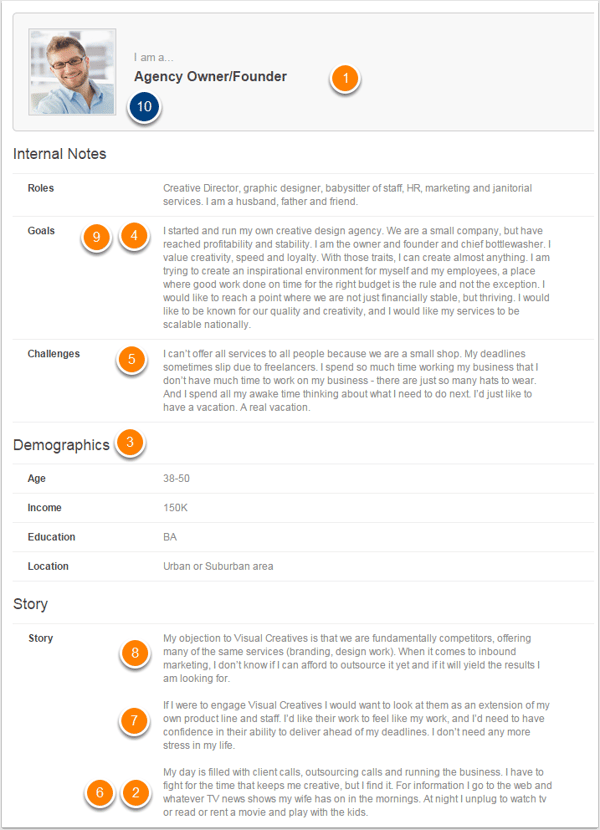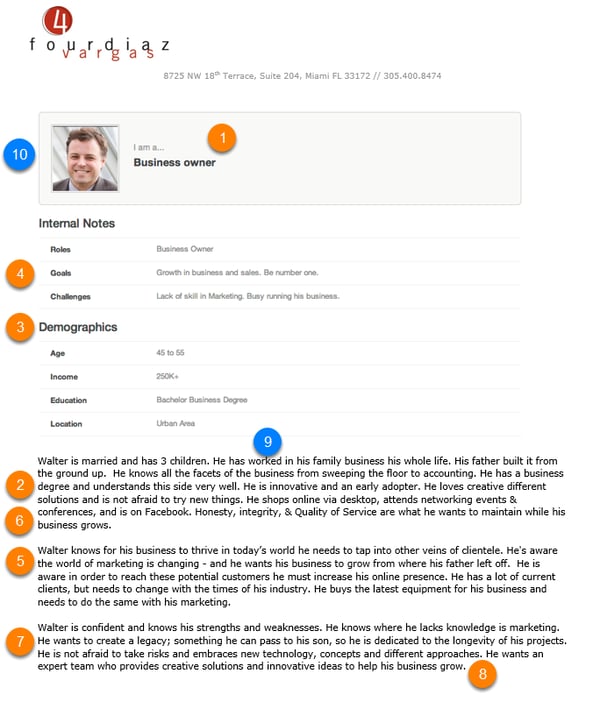The Marketer’s Guide to Buyer Personas
How to create buyer personas (and use them the right way)

There’s nothing more frustrating than spending time and money creating and launching content, only to hear … crickets. Getting a prospective buyer’s attention is harder than ever, due to the sheer volume of content out there.
So how do you stand out? By making sure you tailor your content toward the right people – the ones who stand the best chance of loving (and buying) what you have to offer.
The question is: Who are these people?
That’s where buyer personas come in.
By making smart use of buyer personas, you can gain a crystal-clear picture of who you’re creating content for, so you can tailor your content AND its distribution to cut through the chatter and pique their interest.
“One of the worst things that you can do with your marketing is try to be all things to all people,” explains our own Beth Carter, founder and chief strategist of Clariant Creative. “If you don't have a good focus on who you're talking to, you end up writing and creating really wishy-washy content. Having a buyer persona helps save you from that.”
In this guide, we’ll share expert information, insights from fellow marketers, and helpful links, so you can learn:
- What buyer personas are (and what they aren’t!)
- Why buyer personas are so important and how much of a difference they can make to your marketing ROI
- How to create in-depth, effective buyer personas that will transform your content efforts
- Practical steps to help you make the most of your buyer personas every single day
Ready? Let’s dive in!
Prefer to save this guide and read it later?

Table of Contents:

HubSpot defines buyer personas as semi-fictional representations of your ideal customers based on data and research. They give your entire organization—from marketing to sales to service and beyond—insight about the customers you want to target (and those you don’t). Buyer personas help you focus on qualified prospects, inform product development of your target customers’ needs, and provide useful information to all customer-facing departments who your customers are. Think of buyer personas as dossiers on the typical types of customers who best align with your products or services.
Our own Director of Content, Krista Elliott, recently spoke with her friend Natalie Davison, co-founder of Marrow Marketing, about buyer personas. We’ll be sharing pieces of their conversation throughout this page, but first, let’s hear what they had to say about what buyer personas are:
What Makes a Great Buyer Persona?
Great buyer personas provide valuable insights about your customers and have several key elements in common.
Realistic representation
While buyer personas are hypothetical customer types, they should be recognizable, semi-fictional characters who could easily represent people you know or may have met. From reading a buyer persona, you should have an impression of who they are, what problems they have, and how they currently go about solving those problems.
Memorable personas are often named in a way that clearly identifies their role, such as CFO Susan or Marketing Director Dan. And they usually include a profile photo that helps paint the picture.
In the example persona here we see HR Tina Manager. Right away, you get a good idea of who this persona represents, from the picture to the words describing her: “She is a revolutionary and wants to make a difference at her organization.”

Demographics
Demographic information helps segment and target messaging to your customers. Age, income, and education are a baseline for any marketing strategy, but you can also include factors like geographic region, risk tolerance, and any other demographic data points that will help you be more specific in targeting. Even if you just stick to the basics, make sure to be as specific as possible.
Goals
Great personas include generalized goals that tell you what these customers strive to accomplish and helps you align your content, product, and services with those intended outcomes.
“People tend to get caught up with job titles when creating buyer personas,” explains Beth. “The title doesn't really matter – instead, you can consolidate different titles into one persona that is based around the goals and objectives that that person is trying to achieve.”
In this sample Agency Owner/Founder buyer persona, the goals are identified in relation to the company’s growth, giving us more than just where the agency owner/founder persona wants to be, but it also suggests the nuance that this type of owner/founder wants to move to the next level of business development.
Information sources
Standout buyer personas include the sources your customers use for information. This helps provide insight into whether those customers are social media mavens, fans of printed materials, or if they rely on word-of-mouth and professional associations as trusted sources.
Pain points and solutions
Your buyer personas absolutely must identify customer problems and challenges. They inform opportunities for your product or service to benefit your customers, and they help create the foundation for attention-getting content.
In this Business Owner sample persona, we can see the challenges and potential paths to solutions are well-defined. We can also glean from where he accesses information that he’s not terribly mobile savvy.
Common questions
People typically search online to answer questions. Great buyer personas summarize the typical questions your customers ask when searching for information. Knowing those questions is also helpful in guiding content creation for the customers you want to attract.
Should I Create a Negative Buyer Persona?
A negative buyer persona represents the customers least likely to purchase your products or services. They are considered a poor fit for your company and have their own set of characteristics that fall into the categories mentioned.
You should create a negative buyer persona so you can recognize those consumer groups and avoid spending time marketing to people who are not likely to convert. Also, your research into negative buyer personas will help further clarify who your target customers really are.

Buyer Personas Are Not Customer-Specific
You’ll notice from the sample buyer personas highlighted that they could describe many different customers. They’re clear but not specific.
It’s easy to fall into the trap of creating a buyer persona for every customer you have. Buyer personas should not be customer-specific—even if you only have one customer right now—nor should they simply include demographics. Your customers are as much their beliefs and habits as they are their gender, age, and so on.
Also, you don’t need to create a unique buyer persona for every job role within a target customer’s organization. Your focus should be on shared goals, pain points, and existing knowledge levels. You may discover that for your purposes, the CEO and the COO are identical enough in their goals, attitudes, and challenges that they fit nicely into one persona.
“The trick with personas,” says Beth. “Is finding the right balance of not going hog-wild and creating too many personas, but also creating enough buyer personas – and meaningful distinctions between them – if you think you need multiples.”
Helpful Resources:
Looking for more information about the importance of buyer personas?
What is a 'Buyer Persona' and Why is it Important?
Think Buyer Personas Are Boring? Think Again! [video]
What Does a Great Buyer Persona Look Like? Dissecting 3 Real-Life Examples
Buyer Personas: How to Gain Insight Into Your Customer’s Expectations, Align Your Marketing Strategies, and Win More Business by Adele Revella
Buyers personas add tremendous value to your marketing campaign. In a MarketingSherpa case study on the impact of personas, researchers reported a whopping 900% increase in length of webpage visit, 111% increase in email open rates, and 100% increase in the number of webpages visited. Buyer personas have the power to supercharge your marketing efforts in a number of ways.
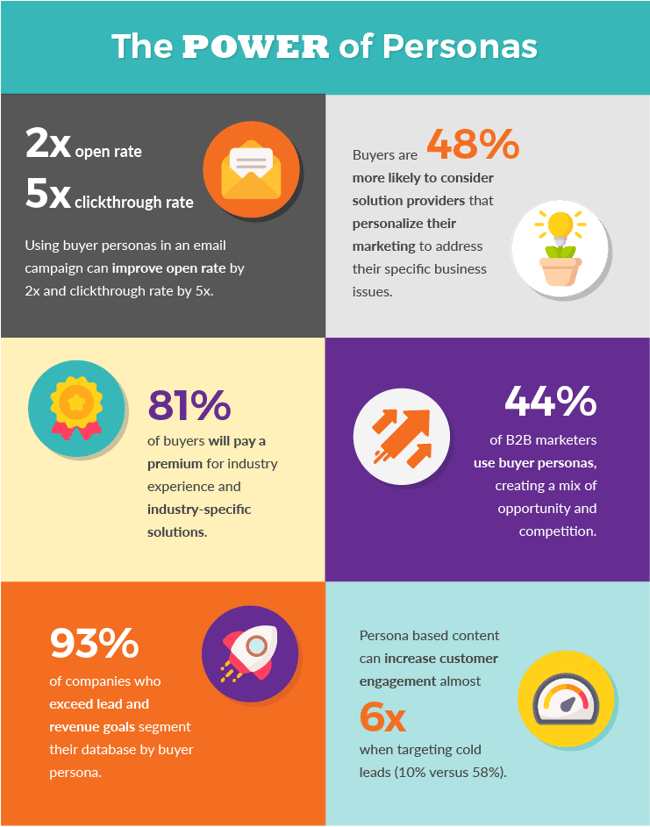
Personas Help You Target Customers
One of the worst things you can do in marketing is to try to be all things to all people. It’s natural to worry that you might be missing the opportunity to sell something to everyone. But the reality is, there is always going to be a target audience for whom your product or service is ideal. If you aren’t focused on that target audience, your content ends up being generic or confusing—and then the customers you want to speak to may simply overlook it.
Buyer personas help you drill down so you can dial in and align with your target customers. Personas serve as a consolidated summary of all the questions you need to answer to best understand those customers:
- Who is this person I’m talking to?
- What are their priorities?
- What are they worried about?
- What goals are they trying to achieve?
- How are they currently attempting to achieve those goals?
- What's preventing them from achieving those goals?
Buyer personas save considerable time and money in your marketing efforts. When you know who your target customers are, their needs, and their pain points, you can align them with your products and services and demonstrate how you solve their problems, producing better results in your messaging and marketing efforts.
HubSpot reports that using buyer personas make websites 2-5 times more effective and easier to use by targeted customers. And personalized emails, which rely on well-developed personas for their creation, improve clickthrough rates by 14%, conversion rates by 10%, and drive 18 times more revenue than broadcast emails.
Personas Help You Understand Existing Customers
By creating your buyer personas based on who is already purchasing and using your products or services, you can gain a more in-depth understanding of why your customers are your customers and how their buyer’s journey looks.
"If you don’t know why people are buying your product or service, you can’t replicate the process," explains our friend and B2B SaaS content marketer Adrienne Barnes. "Otherwise you are essentially throwing spaghetti at the wall, hoping it sticks, and celebrating when it does."
Personas Help You Create Targeted Content
Buyer personas help fine tune your content, making it personal and relevant to your target customers – the basis for inbound marketing.
An inbound marketing strategy relies on useful, valuable content designed to earn brand awareness and build trust as prospects search for information related to your product or service.
To effectively and efficiently create this tailored content, however, you need a clear understanding of your target customers.
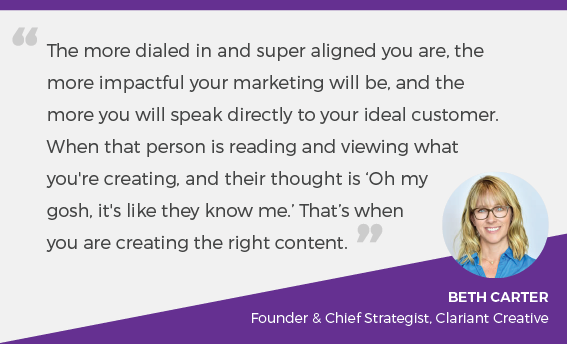
Personas help identify the language your target customers speak. If you sell athletic shoes, and the persona you’ve created tends to call them “tennis shoes,” referring them as “sneakers” in your content won’t resonate and they’ll have a harder time finding you via search engines.
Personas also help distinguish between target customers who, on the surface, seem to have the same needs and goals, but are actually different.
“One of our clients has two key buyer personas: one focused on managing software for the company and the other focused on managing all of IT for the company. While both of those personas certainly have commonalities and similarities, they each have a very different perspective,” explains Beth. “It’s important to keep in mind with our marketing efforts so both customer groups find content pertinent to their goals and pain points.”
In this example, the software manager’s goals are related to the IT manager’s goals; both are concerned with keeping the company running and operating efficiently and securely. But the IT manager has more of a big picture perspective, and the software manager’s perspective is much narrower. Each of them search for information, asking different questions. Knowing this type of distinction is critical to a successfully speaking to your customers in a personal way.
Personas Highlight New Business Opportunities
The old adage about looking at your problems as opportunities is 100% accurate when it comes to inbound marketing and creating buyer personas.
Not only can you use personas to align your existing products or services with customer needs; they can give you important insight into the type of products and services you should develop and market to address needs not being met.
In a way, creating your buyer personas is like holding a focus group: You gain valuable information about why your customers are your customers, what solutions your target customers are searching for, and where the opportunities lie for your next release of products or services.
Helpful Resources:
Looking for more information about the importance of buyer personas?
Finding Your Audience: The Importance Of Developing A Buyer Persona
Why Creating Buyer Personas Is So Important In Branding
5 Reasons Why Creating Buyer Personas Are More Important Than Ever For Businesses
How to Create Detailed Buyer Personas for Your Business [+ Free Persona Template]
Now that you know why you should create buyer personas for your customers, let’s look at how you create them.
Step One: Learn About Your Customers
This is the most important step. It’s your chance to move past pleasantries and surface conversations, and really dive into who your existing customers are.
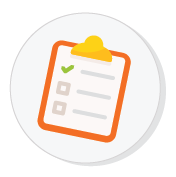 “A lot of people create these … I call them Salesgirl Sally personas, where Salesgirl Sally is 23, and she hates having to make her quota,” explains Adrienne. “And she loves red shoes and is never late for work, and blah, blah, blah. It’s superficial information that doesn’t help anybody do anything. Unfortunately, a lot of companies have very surface-level buyer personas.”
“A lot of people create these … I call them Salesgirl Sally personas, where Salesgirl Sally is 23, and she hates having to make her quota,” explains Adrienne. “And she loves red shoes and is never late for work, and blah, blah, blah. It’s superficial information that doesn’t help anybody do anything. Unfortunately, a lot of companies have very surface-level buyer personas.”
The more information you have, the more accurate your personas will be. There is a myriad of resources you can access to gather data: conducting one-on-one interviews, surveys, product review mining, analytics, and feedback from your organization’s customer service and sales teams.
In the same way that your customers search for information with specific questions, you will be doing the same in gather information about them. So the first thing to do is create the list of questions that cover all the information you want to gather about your customers.
Who are they in their personal lives?
How much do you know about their personal background? It may be gauche to ask your customer’s age under normal circumstances, but it’s a demographic data point you will need.
Find out about their family life. Where do they live and is it different from where they work? Ask about their educational background and what they do for fun.
Your customers’ personal background can tell you a lot about their choices and the assumptions they’ve developed through their upbringing or their environment.
What is their industry?
Next, focus on their industry. Ask about their industry, the size of their company and how that compares to the rest of the industry. What challenges are common in their industry? What is new and exciting? Is their industry conservative, innovative, nurturing? How does the decision-making process work in their industry?
Who are they at work?
Find out their job title. Some companies hand out creative titles that you may not recognize. If they are a Chief Thought Leader, for example, ask them what the parallel roles would be in other companies.
Have your customer describe their typical workday and job responsibilities (both official and unofficial). Is your customer new to their role or a seasoned veteran? Their professional background and experience can determine where a customer looks for information and what type of information they seek out.
What does success look like in their role, and what are their biggest frustrations with the job? Don’t forget to ask what they love about their job too.
What are they trying to accomplish?
Your customer has goals and objectives that likely roll up to key performance indicators (KPIs). What are they? Have them talk about how they are already working to achieve those goals, what challenges prevent them from being successful, and how they tackle those challenges.
Who is in charge?
One of most frustrating aspects of sales and marketing is finding out that you’ve not been targeting the decision maker or, at the very least, an influencer. Is your customer involved in the buying process for products or services like yours? Who do they report to? Who do they trust for advice and information?
What do they NOT like about your product or service?
No one likes to hear complaints, but it truly is a gift when your customer is willing to share what they don’t like about your product or service. Not only does this give you valuable insight on how to make your product or service better, it gives you the inside view on what your buyer persona’s ultimate wish list is.
Where do they get their information?
Learn which types of media your customer is most comfortable with and considers to be the most trustworthy. Do they turn to publications, blogs or social media posts to research new products and find solutions to their problems? Find out if they belong to social or industry-related groups and associations. And, of course, ask them how they found out about your company.
Step 2: Conduct Customer Interviews
 Once you’ve determined what you want to know about your customers, your next step is to identify who, specifically, you’re going to talk to.
Once you’ve determined what you want to know about your customers, your next step is to identify who, specifically, you’re going to talk to.
Keep in mind, you don’t have to speak to 50 people. The goal is to find commonalities in needs, goals, and challenges. Your best bet is to speak to people who represent your customer base. You can approach this two ways.
Biggest fan to meh customers
Adrienne Barnes recommends interviewing four to six people in three different groups: Biggest fan customers, greatest enemies customers, and what we’ll call meh customers.
- Biggest fan customers are the people who swear by your product or service. They likely recommend your company to others by word-of-mouth and social media. These are your evangelists.
- Greatest enemy customers are the people who took a long time to convert or they were on a sales trial. Likely, they changed their mind quickly and either returned the product or canceled their service. They may have even registered a complaint. These customers will help you develop your negative buyer persona, which will help limit the amount of time you spend marketing to the wrong customers.
- Meh customers generally require some time to convert a sale. While they continue to buy your products and subscribe to your services, they’re not shouting from the rooftops about your company. On the same note, they aren’t complaining either.
“You want to talk to all three of those groups because they're all going to give you some really good insights,” explains Adrienne. “The greatest enemy customers are my favorite people to talk to because they have no qualms telling me what didn’t work for them. What expectation did we not meet? Why did they think we were going to meet that? What was it about our copy and content that made them think we were a good fit? Those answers can reveal a lot.”
Glass half full approach
Another way to approach selecting the customers you interview is to talk to decision makers and influencers at a handful of your best fit clients. This allows you to home in on your exact target customer and truly understand at a deeper level what makes them the best fit for your products or services, or vice versa.
Beth points out that when you are seeking customers to interview, sometimes the sales representatives or account managers are protective of their customers and don’t allow the marketing team to have access. “That's probably the most common obstacle we see,” she says.
If this happens, it’s worth speaking with the sales reps to talk about your mutual goal: better leads. After all, the better you understand the customer, the more your marketing will attract the right leads. But if you’re still unable to access those customers, you can still interview the sales reps, ask for service chat logs, or seek out recordings from customer calls. It's not as good as being able to interview the customer, but it's better than nothing.
Step 3: Take Advantage of Online Resources
 In addition to customer interviews, online resources are great for gathering target customer data to build your buyer personas. Here are a few of our favorites:
In addition to customer interviews, online resources are great for gathering target customer data to build your buyer personas. Here are a few of our favorites:
- A great place to start is Quora, which is a clearinghouse of questions asked and answered by members. It’s completely searchable and can offer tremendous insight. Look for questions related to the type of products or services you provide, including your brand. You may find reviews and more personal information from the people who post. You can also look at the other questions they pose and answer on the app to get an idea of what type of information they look for, their general demeanor, and other information they may reveal.
- Reviews are also an excellent source of persona information, telling you in the customers’ own words what they were looking for and what they like (or dislike) about their purchase. You can go on Amazon and see a thousand reviews of your product and your competitor’s products and get a good feel for what your buyer wants and needs.
- If you are a B2B company, however, finding reviews can be a bit trickier. If you’re in SaaS, IT or marketing, however, a great source of customer reviews is Clutch.co. Even if your own company has no reviews, looking at the review of competitors (or companies you aspire to emulate) can provide priceless insights about the priorities and mindsets of your target buyer. For example, if your company offers managed IT services, you can look at other companies’ reviews and notice that many reviews talk about transparency and accountability. This is obviously a high priority for customers in this space, giving you valuable intel that will help shape your messaging and content.
- Social media can also be a useful tool: Search for your own company name and the names of your competitors. What are people saying? What complaints or recommendations do they have? And who are the people talking?
- Additionally, you can check out industry association websites for events and publications that talk about customers and partner organizations. Look at what the industry as a whole is talking about and the type of content being published, particularly thought leadership content – these are the topics your buyer persona likely has on their radar right now.
- If the industry association holds an event, look at the titles and descriptions of breakout sessions, workshops, and the subject of keynotes. Most often, the problems and challenges an industry is dealing with will be addressed at conferences and events.
What If We Don’t Have Customers Yet?
You can still gather data about the customers you want to target by research the companies you consider your competitors – or the companies you aspire to emulate. Who is buying their products and using their services? What do their reviews say? Who loves them and who doesn’t? Most importantly, look for patterns in the information you gather.
Step 4: Segment Customer Data
 Now that you have a big bucket of data points about your existing and/or target customers, you’ll need to put them into groups based on commonalities.
Now that you have a big bucket of data points about your existing and/or target customers, you’ll need to put them into groups based on commonalities.
The question is, which commonalities matter and which don’t? This will vary from persona to persona so a good question to ask yourself is “Does this commonality impact the customer’s purchasing decision or how you market to them? If the answer is no, the commonality is likely not relevant.
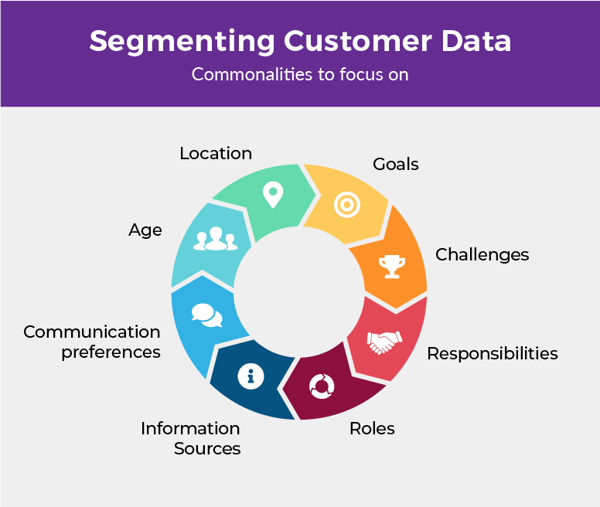
Start segmenting by goals
Segmenting isn’t a singular exercise where you look at one factor, drop customers into buckets accordingly, and move forward. Part of the process is looking at the segmentation and determining if it makes sense. In some cases, a segmentation based purely on goals is the most effective.
An easy B2C example of segmentation by goals is a dance center. You would speak very differently to parents of young dancers than you would to couples taking dance lessons for their wedding.
Starting with goals is a great way to segment at a high level what problems customers are trying to solve. From there, you can overlay other commonalities, such as job roles and responsibilities, information sources and communication preference, age, and location.
Look for patterns
Adding the nuances of other commonalities and seeing patterns within those combinations helps you identify strong personas.
Using the example above, you may combine attributes until you settle on two personas:
 Dance Mom Dana: A thirty-something stay-at-home mother of three who wants a healthy activity for her children. She loves Instagram and is seeking a dance center that offers plenty of options, has highly qualified instructors, and keeps things fun.
Dance Mom Dana: A thirty-something stay-at-home mother of three who wants a healthy activity for her children. She loves Instagram and is seeking a dance center that offers plenty of options, has highly qualified instructors, and keeps things fun.
 Wedding Dance Wendy: A mid-level professional in her late twenties who is engaged and wants to dazzle her guests on her wedding day. Her fiancé (or fiancée) isn’t completely on board with the idea of dance lessons. Wendy is combing Twitter and Facebook, asking for recommendations for a place that’s great for beginners but that won’t embarrass them by putting them in a kids’ class.
Wedding Dance Wendy: A mid-level professional in her late twenties who is engaged and wants to dazzle her guests on her wedding day. Her fiancé (or fiancée) isn’t completely on board with the idea of dance lessons. Wendy is combing Twitter and Facebook, asking for recommendations for a place that’s great for beginners but that won’t embarrass them by putting them in a kids’ class.
Focus on quality over quantity
One of the big questions in creating buyer personas is how many you need to create. You may not need to create as many buyer personas as you think. Internationally recognized marketing blogger, Mark Schaefer says that 3-4 personas usually account for over 90% of a company's sales.
Focus on the personas that best represent your customers. This doesn’t mean you dispose of the other data you’ve collected. You may discover that over time, your buyer persona evolves along with your company, and a previously minor persona may begin to take center stage.
Create a meaningful template to tell the persona’s story
Once you’ve figured out which personas you will create, you’ll want to categorize and capture the information you’ve gathered about them in a compelling, easy-to-read, and highly usable way.
You may even want your designer to develop a template that follows your brand guide. The goal is to make sure you clearly highlight who the buyer is, what they want to achieve, what language they use, and what their pain points and triggers are.
Helpful Resource:
Looking for more information about creating buyer personas?
Marketers often struggle with this. They painstakingly create well-constructed buyer personas that gather electronic dust sitting in a folder on the cloud. When used strategically, however, buyer personas can shape your content and your relevancy with customers. Here are six great ways to use buyer personas:
Use Buyer Personas to Develop Content Strategy
Let’s start with how buyer personas can shape content creation. You should reference your personas while developing your content calendar and creating your briefs, always asking yourself, “Will this content resonate with my buyer personas?”
“When we create content strategy for a client, we start by building out a content calendar, usually a spreadsheet with columns for blog posts, publish dates, keywords, and who the post will target,” says Beth. “We usually have a column to identify which stage of the buying journey the content applies to, and a column for the buyer persona we’re speaking to.”
Beth also points out the importance of making sure the content strategy in your marketing plan accounts for all your buyer personas.
Use Buyer Personas to Identify Content Topics
Remember those pain points and questions you tracked while collecting data? Each of those can easily be converted to content in the way of blogs, videos, podcasts, promotional offers, email campaigns, and more. Using what you know about your buyer personas’ pain points and questions, you can create content to address and answer them.
In fact, that is a great place to start planning your content calendar. More than likely, your buyer personas have enough questions and challenges to keep your content creation team quite busy.
Use Buyer Personas as a Muse When Writing
Even when writing, you can find ways to keep your personas top of mind. Some content writers frame the stock photo used in the persona and place in their front of them to make sure they are keeping that persona in mind. Others use bobblehead figures or create their own LEGO characters.
Regardless of how creative you are in physically representing your buyer personas, the idea is to imagine you are writing for this representative person, their needs, goals, and challenges. The more you focus on speaking directly to your persona, the more targeted your content will be.
Use Buyer Personas to Stay Relevant
As your marketing campaign develops and you continue to create content for your personas, keep in mind they will need to be updated. Buyer personas represent people. And people change and grow.
“Your buyer persona description should be a living document,” explains Adrienne. “If it becomes a one-and-done thing that only lives on the marketing director’s computer, then it’s pointless.” This doesn’t mean you have to interview all your customers again, but you may want to do some social listening and pay attention to your customer reviews online.
Your sales and service team should be strong allies in this information-gathering as well, telling you what their customers – and the interactions with them – are like. Ask your service and sales teams if they’ve received complaints and what they are. Find out what they’ve found that excites customers about your product or service.
Create a database, app, or some other method for your service and sales team to track this information so you can access it and look for common issues and benefits you may not be addressing in your content. Then use the information you gather to review your buyer personas to make sure they are still accurate.
A good rule of thumb is to review and update your buyer personas annually before you begin to plan your marketing strategy for the year. If you plan quarterly or semi-annually, you may not need to do a full review, but it’s important to make sure your personas are up to date so your content remains relevant. Unusual circumstances, such as a pandemic or an industry change, regardless of when it happens, likely warrants at least a quick review to make sure your customers’ habits and needs haven’t changed.
The result? Content and copy that attract the right viewers and turn them into strong leads – the shared goal of sales and marketing alike.
Use Buyer Personas to Enter New Markets
If you’re looking to break into a new market, take a look at your buyer personas and evaluate whether you need to create a new one to fit your new audience segment. If so, follow the same creation process. You may find the patterns appear earlier in the process and segmentation is easier because you have existing personas that could like “sisters” with key differences. Again, do not create new personas if you don’t need them. In some cases, companies find they are simply creating new products or services for the same customers.
Use Buyer Personas to Delight Your Customers
Buyer personas are typically created and mostly used by your marketing, sales, and services teams, but your entire organization can benefit from them. Every department in your organization that either drives strategy or interacts with customers should be familiar with the personas. From accounts receivable to product fulfillment, right up to the CEO – knowing who your customers are, in what manner they prefer their communication, and the responsibilities they juggle, can help your organization serve its customers so much better.
Helpful Resources:
Looking for more information about using buyer personas?
Now That You've Created Your Buyer Personas, Here's How To Effectively Employ Them

Buyer personas are powerful tools to help you plan and create the type of relevant, focused content that will grab and keep your ideal buyer’s attention. They focus your marketing efforts on the customers’ perspective – informing what medium should be utilized and the messaging that will resonate with them the most. To create the most valuable buyer personas, you’ll need to dive in and really get to know your customers through interviews, online audits, and social listening. Just like your customers, buyer personas need to be revisited and updated to reflect the changes in your customers. Finally, your buyer personas can serve as a guide to help your entire organization align in meeting your customers’ needs.
Need more help to get started? We’ve helped many small marketing teams create great, actionable buyer personas, so get in touch if we can help you out!

